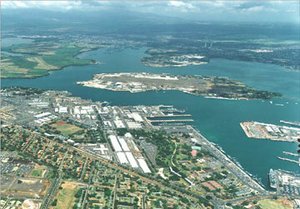|
Pearl Harbor PearlsAre there pearls in Pearl Harbor?
If you've ever asked yourself this question concerning Pearl Harbor pearls...you'll be glad to read the following article.
Hawaii’s pearl oysters down but not quite outBut when today's date reminded me of Pearl Harbor, I remembered the little pearl book and dug it out. Reading it soon made me realize that besides its military history, Pearl Harbor holds an important place in the history of Hawaii's bygone Pearl Harbor pearl oyster industry. Ancient Hawaiians were well aware of the value of Pearl Harbor's natural resources, which included birds, fish and invertebrates. Among these invertebrates were oysters, called i'a hamau leo, meaning "sea creature that silences the voice." This name came from a taboo that forbade people from talking while collecting oysters. Hawaiians ate oysters either cooked or raw and used the mother-of-pearl shells for fishhooks, believing the sheen attracted fish. They also used the shells to decorate bowls, as eyes for their sculpted gods and as scrapers to make rope and cloth. No one knows if these ancient people valued the pearls, called momi, that sometimes grew inside these oysters. No Pearl Harbor pearls have been found in archeological digs, nor do ancient chants mention pearls. There is no question, however, that early European settlers shed new light on pearls for the Hawaiians. When King Kamehameha I learned of the value the newcomers placed on pearls, his oyster divers' mission changed dramatically, shifting from food and shell gathering to pearl hunting. The king's punishment for unauthorized oyster fishing in Pearl Harbor was death. Thus, by 1812, the Pearl Harbor pearl trade was a valuable monopoly for Kamehameha. But not for long. By the 1840s, deforestation and overgrazing of livestock around Pearl Harbor caused tremendous damage to the surrounding land. Rain washed tons of silt and debris into the streams that fed the harbor, and soon the harbor itself was choked with dirt. Of course, the oysters didn't survive.
By 1901, Pearl Harbor pearl oysters were almost entirely gone, smothered by mud. Since Hawaii's oysters didn't grow in abundance in any other part of the main islands, the pearl fishery seemed finished. But early in this century, Captain James Anderson discovered large oyster beds at Pearl and Hermes Reef, 1,100 miles northwest of Oahu. The oysters in this remote atoll were a bigger species than the tiny ones in Pearl Harbor. These larger oysters are found throughout the islands, but were abundant only at Pearl and Hermes. (Ironically, the name of this atoll had nothing to do with pearls. It's name came from two English whalers, the Pearl and the Hermes, which were wrecked there in a storm.) I didn't have to read further to figure what happened next: Pearl hunters decimated this second, and last, natural oyster population of Hawaii. No one, however, made their fortunes from it. Between 1927 and 1930, people collected and removed 100 tons of oysters from the atoll's lagoon. From all those oysters, only about a quart of pearls was obtained. Of those, only a small number were good (meaning valuable) pearls. Today, there's good news and bad news about Hawaii's oysters. The bad news is that the Pearl and Hermes oysters have not remotely recovered their numbers. The good news is that, conversely, Pearl Harbor pearl oysters are making a comeback. Perhaps someday, the mention of Pearl Harbor will once again remind people of shellfish, pearls and Hawaii's natural bounty.
|












